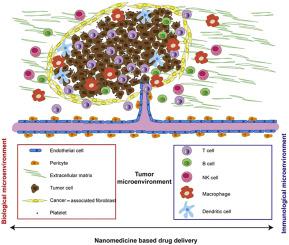Acta Pharmaceutica Sinica B ( IF 14.7 ) Pub Date : 2020-05-31 , DOI: 10.1016/j.apsb.2020.05.008 Jin Li 1 , Diane J Burgess 1

|
The complex tumor microenvironment is a most important factor in cancer development. The biological microenvironment is composed of a variety of barriers including the extracellular matrix and associated cells such as endothelia cells, pericytes, and cancer-associated fibroblasts. Different strategies can be utilized to enhance nanoparticle-based drug delivery and distribution into tumor tissues addressing the extracellular matrix or cellular components. In addition to the biological microenvironment, the immunological conditions around the tumor tissue can be very complicated and cancer cells have various ways of evading immune surveillance. Nanoparticle drug delivery systems can enhance cancer immunotherapy by tuning the immunological response and memory of various immune cells such as T cells, B cells, macrophages, and dendritic cells. In this review, the main components in the tumor biological and immunological environment are discussed. The focus is on recent advances in nanoparticle-based drug delivery systems towards targets within the tumor microenvironment to improve cancer chemotherapy and immunotherapy.
中文翻译:

基于纳米医学的肿瘤生物和免疫微环境药物递送
复杂的肿瘤微环境是癌症发生发展的最重要因素。生物微环境由多种屏障组成,包括细胞外基质和相关细胞,如内皮细胞、周细胞和癌症相关成纤维细胞。可以利用不同的策略来增强基于纳米颗粒的药物递送和分布到肿瘤组织中,以解决细胞外基质或细胞成分。除了生物微环境外,肿瘤组织周围的免疫条件也非常复杂,癌细胞有多种逃避免疫监视的方式。纳米颗粒药物递送系统可以通过调节T细胞、B细胞、巨噬细胞和树突状细胞等各种免疫细胞的免疫反应和记忆来增强癌症免疫治疗。在这篇综述中,讨论了肿瘤生物和免疫环境的主要组成部分。重点是基于纳米颗粒的药物输送系统针对肿瘤微环境内的靶标以改善癌症化疗和免疫治疗的最新进展。











































 京公网安备 11010802027423号
京公网安备 11010802027423号